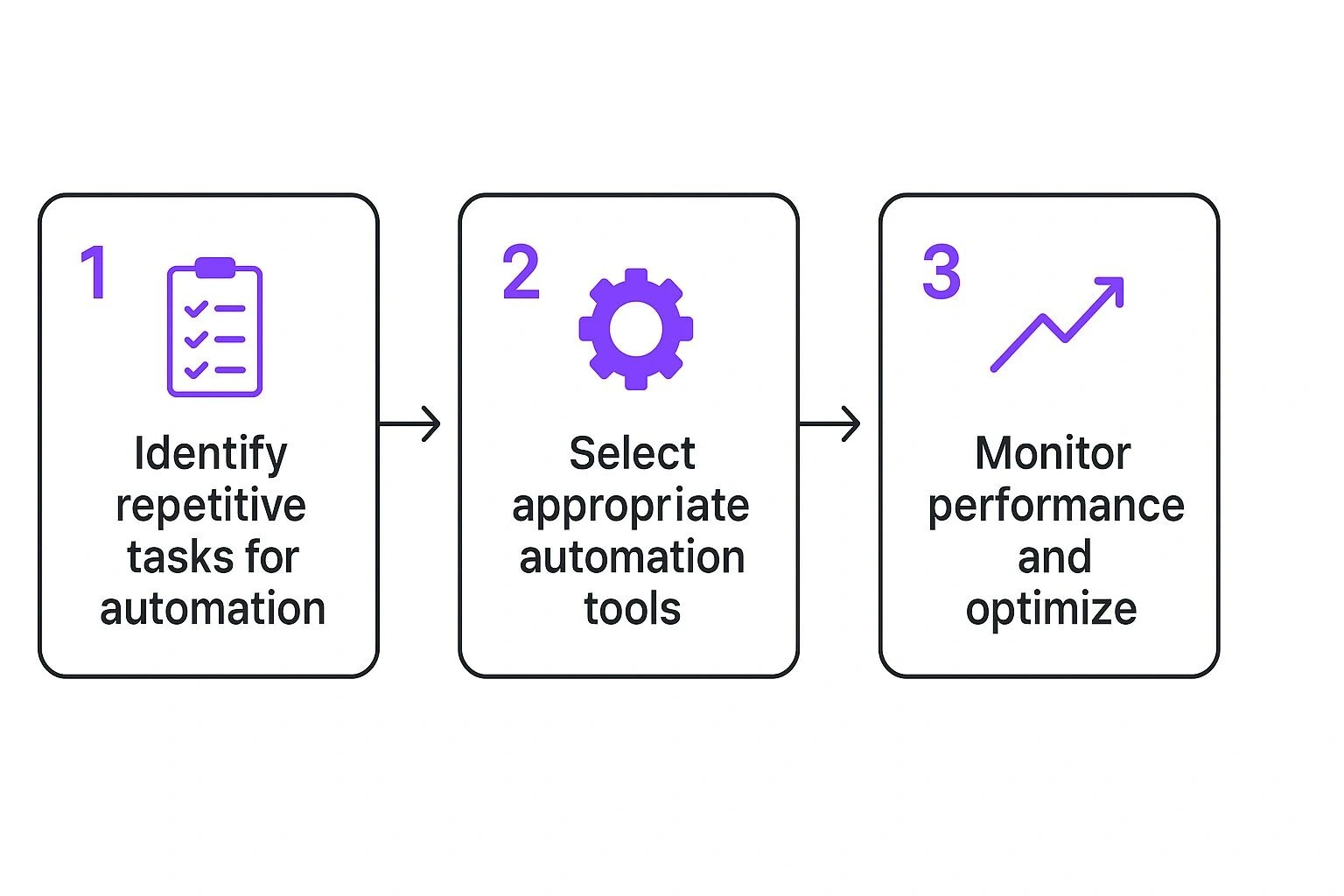How to Automate Business Processes: Expert Guide
Learn how to automate business processes with expert strategies from Australian firms. Practical tools, tips and real examples to streamline operations.

The Australian Automation Reality Check

Forget the Hollywood robot apocalypse.The reality of business process automation in Australia is much more down-to-earth.It’s not about replacing humans; it’s about making their jobs better.Talking with business owners around the country, I’ve seen how automation is changing the game, fixing real issues, and creating new possibilities.
One thing I keep hearing is that successful automation is targeted automation. Smart Aussie businesses aren’t just following the crowd. They’re focusing on processes that are actually holding them back, like slow approvals, manual data entry, or endless reports.This focused approach is the key to getting a real return on investment and avoiding major disruptions.
Another thing I’ve noticed is that there’s no one-size-fits-all solution. What works for a Melbourne tech startup isn’t necessarily right for a Brisbane manufacturer.Businesses are looking for solutions that fit their specific needs, whether it’s dealing with tricky compliance rules or managing skills gaps.If you’re feeling lost, checking out some business process automation consulting strategies can be super helpful.
Speaking of the current landscape, did you know that as of 2024, over 35% of Australian businesses have adopted AI or automation tech? It’s a real sign of the times.We’re seeing much faster adoption, particularly in tech-savvy industries and larger companies.Want to learn more about these adoption rates? Check out this article: AI and Automation Adoption in Australian Businesses.
The Automation Advantage Down Under
The advantages of automation are becoming super clear here in Australia:
- Increased Efficiency: Automating those boring, repetitive tasks frees up time and resources, so staff can focus on more important things.
- Improved Accuracy:Humans make mistakes.Automation doesn’t (as much).This means better data, better reports, and better decisions.
- Enhanced Compliance: Automating compliance processes helps businesses keep up with regulations and avoid hefty fines.
- Better Customer Experience: Streamlined customer interactions mean faster responses and more personalized service – everyone wins.
Beyond the Buzzwords
So, what’s the bottom line?Automation isn’t magic, but it is a powerful tool.When used strategically, it can seriously benefit Australian businesses.It’s all about finding the right processes to automate, picking the right tools, and managing the change well.The businesses that are really killing it are the ones that see automation as a chance to get better, not a threat. They’re building a future where tech and human ingenuity work together for amazing results.
Finding Your Automation Gold Mine

This infographic nicely visualizes the core steps in business process automation: finding those repetitive tasks, picking the right tools, and constantly checking in to see how things are performing. It really highlights that automation isn’t a “set it and forget it” kind of deal.You’ve got to keep tweaking and refining based on what actually happens in practice.
Let’s get down to brass tacks and figure out how to spot those prime automation opportunities in your business.A lot of companies get tripped up trying to automate everything all at once.It’s like trying to remodel your entire kitchen in an afternoon – a recipe for disaster! The smarter move is to zero in on the processes that are truly crying out for automation.
Identifying the Pain Points
So, how do you tell the difference between a real bottleneck and a minor inconvenience? A good place to start is to look for processes that are:
- High-frequency:If it happens daily or even multiple times a day, you’re looking at a prime candidate.Think about how much time you could save by automating something that happens constantly.
- Error-prone: Manual processes are naturally prone to human error. Data entry flubs, calculation mistakes, missed deadlines – these all add up. Automation can drastically cut down on these issues.
- Time-consuming:Is this process a major time suck for your team?Automating it can free them up to focus on more strategic, high-value work.
- Frustrating:Let’s be honest, some tasks are just plain annoying.Automating these can boost team morale and reduce turnover.Nobody wants to spend their day doing soul-crushing, repetitive work.
Calculating the Hidden Costs
It’s also important to consider the hidden costs of manual processes.These don’t always show up clearly on a spreadsheet. For example, a small data entry error might seem minor, but what if it leads to a wrong invoice or a delayed shipment? Suddenly, the downstream costs become significant. Check out some business process automation examples to get a better sense of the potential impact across different business functions.
Similarly, approvals stuck in limbo can ripple through your whole organisation.Projects get delayed, clients get frustrated, and your bottom line takes a hit.Think about a purchase order sitting in someone’s inbox for days.That’s lost productivity and potential revenue. Recent stats show automation is helping Australian businesses dramatically reduce errors and boost efficiency.For instance, workflow automation can slash errors by up to 70%.Pretty impressive, right? Discover more insights.
Prioritising Your Automation Projects
Once you’ve identified potential opportunities, it’s prioritisation time.Don’t get distracted by the shiny, complex projects.Often, the biggest wins come from automating the mundane, repetitive tasks that nobody wants to do anyway.This is where you’ll strike gold.
A simple way to prioritise is to think about impact versus effort.Focus on projects that deliver a high impact with relatively low effort.This builds momentum, shows quick wins, and gets everyone on board for more ambitious automation projects later on. Remember, the goal isn’t to eliminate jobs; it’s to eliminate the tedious parts of jobs so your team can focus on what really matters.
To help you further evaluate potential automation opportunities, I’ve put together this handy table:
| Process Automation Opportunity Assessment A practical framework for evaluating which business processes are prime candidates for automation based on frequency, complexity, and impact |
Process Type | Automation Potential | Implementation Difficulty | Expected ROI Timeline |
|---|---|---|---|---|
| Data Entry | High | Low | Short-term (3-6 months) | |
| Invoice Processing | High | Medium | Short-term (6-12 months) | |
| Customer Support (basic inquiries) | Medium | Medium | Mid-term (12-18 months) | |
| Claims Processing | High | High | Long-term (18+ months) | |
| Regulatory Reporting | Medium | High | Long-term (18+ months) |
This table provides a general overview; the specifics will obviously vary depending on your individual business context. However, it highlights the importance of considering not just the potential benefits but also the implementation challenges and expected ROI timeline. Starting with processes that are high-impact and low-effort is a great way to build momentum and demonstrate the value of automation.
Tool Selection Without The Marketing Nonsense

The automation software market can feel overwhelming.So many vendors, so many promises…How do you cut through the noise and choose tools that actually deliver for your business here in Australia?Let’s ditch the jargon and get down to brass tacks.
The real secret is matching the tool to what you actually need, not what looks cool in a demo.I’ve seen too many companies fall for bells and whistles they never end up using, resulting in expensive software that just sits there gathering dust.One tip I’ve found helpful is to prioritise tools that minimise coding requirements. For instance, check out this helpful list of no-code automation tools.It might give you some ideas.
From Simple To Sophisticated: Finding The Right Fit
Luckily, there’s a wide range of automation platforms out there, from simple cloud-based solutions you can set up in an afternoon, to powerful enterprise-grade systems.
-
Cloud-Based Solutions: Great for automating those everyday tasks quickly and affordably.Think email marketing automation with Mailchimp, social media scheduling with Buffer, or basic workflow management with Trello.
-
Robotic Process Automation (RPA): If you’ve got repetitive, rules-based processes that touch different systems, RPA is your friend.Think things like data entry or invoice processing. UiPath is a good example of a popular RPA platform.
-
Business Process Management (BPM) Suites: These are the heavy hitters, comprehensive platforms for designing, implementing, and managing complex processes across your entire organization.Something like Kissflow would fall into this category.
Business Process As A Service (BPaaS): The Aussie Advantage
For many Australian businesses, especially those without massive IT departments, Business Process as a Service is a real game-changer. Think of it like outsourcing your automation headaches. A provider handles everything – setup, implementation, maintenance, the whole nine yards. This frees up your team to focus on what they do best. And the BPaaS market here in Australia is booming!It’s projected to reach US$2.30 billion by 2025. That tells you something about the growing demand for outsourced automation down under.Want to learn more about the BPaaS market? Discover more insights.
Evaluating Vendors: Beyond The Sales Pitch
Choosing the right vendor is just as crucial as choosing the right tool. Don’t just get swept away by a slick sales pitch. Here’s what you should really be looking at:
-
Australian Support: Dealing with overseas support can be a nightmare.Make sure your vendor offers solid local support so you can get help quickly when you need it.
-
Data Sovereignty: Where is your data being stored?This is critical.Choose a vendor that complies with Australian data privacy regulations.
-
Total Cost of Ownership: Don’t just focus on the sticker price. Think about ongoing licensing fees, implementation costs, and training. It all adds up.
-
Scalability: Can the platform grow with your business? Choose a solution that can handle increasing complexity as your needs evolve. For businesses considering scaling their processes, learning more about business process re-engineering steps can be quite beneficial.
To help you compare some of the options available in Australia, I’ve put together a handy table:
Automation Tool Comparison for Australian Businesses
Key features, pricing, and suitability comparison of popular automation platforms available in the Australian market
| Platform | Best For | Starting Price (AUD) | Key Features | Australian Support |
|---|---|---|---|---|
| Zapier | Connecting apps & automating simple workflows | Free plan available, paid plans from $29.99/month | Workflow automation, app integrations, no-code/low-code | Yes |
| UiPath | Enterprise-grade RPA | Contact for pricing | Complex automation, AI integration, attended & unattended robots | Yes |
| Kissflow | Low-code BPM & workflow management | From $390/month | Visual workflow builder, process optimization, reporting & analytics | Yes |
| Microsoft Power Automate | Automating tasks within the Microsoft ecosystem | From $15/user/month | Integration with Microsoft products, workflow automation, AI builder | Yes |
This table provides a snapshot, of course, but it’s a good starting point for your research.Remember to look at the specifics of each platform and how they align with your unique business needs.
By focusing on your practical needs, evaluating vendors thoroughly, and understanding the total cost, you can make smart automation investments that truly benefit your business.It’s about solving real problems, not collecting shiny new tech toys.
Your First Automation Project That Actually Works
Okay, so you’re ready to finally bring some automation into your business. Let’s ditch the massive overhaul idea for now. We’ll start small, snag a few quick wins, and build momentum. Think of it like learning to surf.You don’t paddle out to a huge wave break on day one, right?Get comfortable with the smaller waves first.
Mapping Your Process: Honesty is Key
The first thing we need to do is really understand the process you want to automate. I’m talking about the actual, day-to-day reality, not the idealized version in the company handbook. Talk to the people doing the work, watch the process in action, and document every single step, even the tiny ones that seem insignificant.This isn’t about pointing fingers, it’s about getting a clear picture of what’s actually happening.
Designing a Better Way: Keeping it Human
Once you’ve mapped the current process, we can design the improved, automated version.This is where we can get creative and see how technology can make things better. But here’s the important part: keep it human-centered.The best automation works with people, not against them. Think about how this will impact the people using it.Will it make their jobs easier?More enjoyable?More valuable? If not, we need to rethink our approach.
Handling the Hiccups: Expect the Unexpected
Let’s be realistic: no tech rollout is ever perfect. There will be glitches, resistance, and unexpected challenges.The key is to be prepared and have a plan. This might mean extra training, tweaking the automation setup, or just being patient.
Change Management: Turning Skeptics into Advocates
One of the biggest challenges is getting everyone on board.People often worry that automation will eliminate their jobs.Address these concerns directly with honest communication and empathy.Explain how automation will improve their roles, not replace them.Show how it will free them from tedious tasks so they can focus on more interesting, higher-value work. I’ve seen firsthand how initial skepticism can transform into enthusiastic support.
Testing and Troubleshooting: Get Your Hands Dirty
Before launching company-wide, we need to thoroughly test the automation.Run it in a controlled environment, find any bugs, and iron out the kinks.Involving team members in testing is a great idea.This not only helps spot problems but also gives them ownership and builds confidence in the new system.The screenshot below shows a Zapier dashboard, which visualizes the interconnected automated workflows.
This interface gives you a clear view of how different apps and services are integrated and automated. It shows how Zapier can handle complex automations and provides a central control point for your automated processes.
Measuring Success: Beyond the Metrics
Finally, it’s important to measure the success of your project.But don’t just look at time saved or cost reduced.Look at the bigger picture.Has automation improved employee morale?Boosted customer satisfaction? Made your business more agile and competitive?These are the real measures of success. Remember, automation is a journey. Start small, learn as you go, and keep improving.You’ll be amazed at what you can automate.
Getting Everyone On Board Without The Drama

Let’s be honest, one of the trickiest parts of automating business processes is managing the human element.The worry that automation equals job losses is completely understandable. But in my experience, successful automation in Australian workplaces actually makes jobs better, not worse.
So, we need to change the conversation. Instead of focusing on what automation removes, let’s highlight what it adds – freedom from boring repetitive tasks, chances to learn new skills, and the opportunity to do more engaging work.
Addressing Fears and Building Excitement
This starts with transparency.Talk to your team early and often. Explain the reason you’re automating. What problems are you trying to fix? How will it benefit the company and the employees?
For example, if you’re automating customer service, explain how it will handle routine questions, freeing up your team to tackle complex customer issues that need a human touch and creative solutions.If your initial automation project touches customer interaction, consider a seamless integration like adding a chatbot to your website. This can be a valuable first step.
Practical Training and Empowerment
Training is essential. Ensure everyone has the resources and skills to use the new automated systems effectively. This goes beyond just technical know-how; it’s about empowering your team to use these tools to improve their own work and contribute strategically.
Consider different learning styles.Hands-on workshops might work for some, while others prefer online tutorials.Offer a range of training options to suit everyone.
Involving Your Team: From Victims to Owners
Get your team involved from the beginning. Ask for their input on which processes to automate.Get their feedback on the new systems. This transforms them from passive recipients of change into active participants.When people feel heard, they’re much more likely to embrace change.
This also helps you identify potential problems you might have overlooked.Your team understands the day-to-day realities of these processes better than anyone.Their insights are incredibly valuable for designing automations that truly work.
Tackling Resistance Head-On
Some resistance is inevitable. Listen to concerns empathetically. Acknowledge the anxieties. Then, respond with facts and clear explanations of how automation will improve, not eliminate, their roles.
Fear of the unknown is often the biggest obstacle.By providing clear information, addressing concerns proactively, and showing the positive effects of automation, you can turn doubters into champions.
Building a Culture of Continuous Improvement
The aim is to create a culture where automation is seen as a tool for continuous improvement, not a threat.This takes ongoing communication, training, and a commitment to empowering your team to adapt and thrive. When people see how automation benefits their jobs, they become more open to innovation and growth.
Measuring What Matters And Growing Smart
So, you’ve launched your automation project and things are looking good.Great! But how do you really know it’s delivering? Time saved is a solid start, but it doesn’t tell the whole story.Let’s explore the metrics that truly count, beyond just trimming a few minutes here and there.
Beyond Time Savings: Measuring Real Impact
Think bigger. What were your main goals for implementing automation in the first place?Was it better accuracy?Happier employees?A smoother customer journey? These are the results that really matter to stakeholders.
-
Accuracy:Are errors down?Carefully track error rates before and after automation. This could be anything from fewer typos in data entry to a drop in incorrect invoices.
-
Employee Satisfaction: Is your team feeling less stressed and more engaged?Anonymous surveys can offer valuable feedback. Ask about workload, overall job satisfaction, and how they perceive the impact of automation.
-
Customer Experience: Are your customers noticing a positive change? Keep a close eye on customer satisfaction scores, resolution times, and any direct feedback you receive.Happy customers are more likely to stick around and spread the word.
-
Business Outcomes:Is automation impacting your bottom line?Track key metrics like revenue growth, cost reductions, and overall profitability. These are the numbers that leadership cares about.
For more on process optimisation, especially if you’re thinking about larger-scale changes, check out our guide on how to streamline business processes. I’ve found it super helpful.
Scaling Smart: Avoiding Automation Pitfalls
Scaling automation can be a bit of a tightrope walk. I’ve seen companies get so excited about early wins they try to automate everything at once.This can lead to burnout and a feeling of being overwhelmed.
A better approach is to build on your successes.Start small, prove the value, then use those results to justify investing in more automation.It’s a virtuous cycle that builds confidence and demonstrates clear ROI.
Maintaining Momentum: Keeping the Excitement Alive
Another common trap is losing steam after the initial buzz wears off. Automation isn’t a “set it and forget it” kind of thing. It needs regular attention, tweaks, and adjustments along the way.
Make it a habit to review your automated processes. Are they still performing well? Are there any bottlenecks or areas you can fine-tune?Get your team involved.Their on-the-ground insights are invaluable for spotting issues and keeping things running smoothly.
Staying Current: Navigating the Automation Landscape
The world of automation is constantly evolving. New tools and technologies pop up all the time.It’s tempting to get distracted by the newest gadgets, but the smartest approach is to stay focused on your business needs.
Don’t chase trends.Instead, identify the processes that are really slowing you down.Then, look for tools that specifically address those pain points. This targeted approach is far more effective than jumping on every new bandwagon.
Continuous Improvement: The Automation Advantage
The true strength of business process automation lies in continuous improvement. Use data to monitor performance, identify opportunities for optimisation, and refine your processes over time.This fosters a culture of innovation and ensures you’re always getting the most out of your automation efforts.
By focusing on these key areas – measuring real impact, scaling wisely, staying engaged, keeping your eye on the ball, and continuously improving – you can turn your automation wins into a long-term competitive advantage. It’s about working smarter, not just faster.
Your Practical Next Steps Forward
So, we’ve talked a lot about automating business processes. Now, let’s get down to brass tacks and map out a plan you can use today, no matter how big your company is or what your tech skills are. This is about making real, tangible progress, one step at a time.
Building Your Automation Roadmap: Start Small, Think Big
The biggest mistake I see people make is trying to boil the ocean. Don’t try to automate everything at once!Pick one key process that’s a real headache.Maybe it’s that soul-crushing data entry your team dreads, or the endless email chain for approvals.Focus on that.
Once you’ve nailed that first automation, shout it from the rooftops! Show the results to your team and management. Get people excited.Then, and only then, move on to the next process.
Gathering Your Allies: Building Internal Support
Automation isn’t a solo mission. You need your team, IT, and leadership on board.Identify the key players – the people who will be most affected by the changes or who can really make things happen.
Show them why this benefits them.Will it free up their time?Will it reduce errors? Will it make their team’s numbers look better? Make the case clear, concise, and compelling.
And remember, change can be unsettling. Address any concerns head-on, with empathy and honesty.Explain how automation will make their roles better, not replace them.
Budgeting For Success: Australian Pricing Realities
Let’s be real, automation costs money. You need to invest in software, implementation, the whole shebang.Be realistic about your budget. How much can you actually spend?
Think about the whole picture – not just the initial software cost, but also ongoing fees, training, and any custom development you might need.And remember, Australian pricing and support can be unique. A local provider, like Osher Digital, can often make this whole process much smoother.
Measuring Progress: Keeping Everyone Motivated
How will you know if your automation is actually working?Figure out your key metrics before you start. Are you trying to save time? Reduce errors? Boost customer satisfaction? Make it measurable.
Track your progress regularly and share the results. Celebrate the wins, no matter how small. This keeps everyone motivated and builds momentum for future automation projects.
Ready to Take the Next Step?
Automating your business is a journey, not a destination. Start small, build on your successes, and keep improving. Osher Digital can help guide you through this process, providing expert support every step of the way. We specialise in helping Australian businesses implement automation solutions that get real results. Ready to transform your business processes and unlock new levels of efficiency? Visit Osher Digital today to learn more.
Jump to a section
Ready to streamline your operations?
Get in touch for a free consultation to see how we can streamline your operations and increase your productivity.